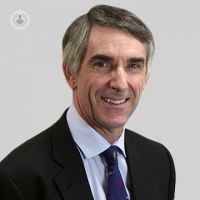Scaphoid fracture: symptoms and treatment options
Escrito por:There are eight carpal bones in the hand. The most common one to be fractured is called the scaphoid. This is a small bone which lies between the thumb and the side of the wrist. Scaphoid fractures can be caused by falling onto the hand, or by anything which forces the wrist backwards, or by punching injuries. Here, one of our expert orthopaedic surgeons Mr James Nicholl explains more, from symptoms to how the condition is treated if it does not heal.
What are the symptoms and how is it diagnosed?
Patients complain of pain in the wrist, there may be slight swelling, pain trying to move the wrist, and pressing on the side of the wrist is tender. Scaphoid fractures can usually be diagnosed with an X-ray, but sometimes there is a fracture which isn’t visible on a plain X-ray. In which case a CT or MRI scan will show it.
The scaphoid is a notorious bone for causing long-term problems and because of its shape, it can be difficult to diagnose fractures. The bone has a poor blood supply, which makes it more difficult for fractures to heal.
About one in ten scaphoid fractures do not heal when treated in a cast. The likelihood of a scaphoid fracture not healing is increased if the wrist has not been immobilised in a cast, if the fracture is of the proximal pole of the scaphoid, if the fracture is displaced, or if the patient is a smoker.
Some patients think they have just sprained their wrist and don’t attend hospital or they do, but the X-ray looks normal and the fracture is not diagnosed, and they don’t, therefore, get treated.
How are scaphoid fractures treated?
For most scaphoid fractures, there is very little displacement between the two parts and the fracture is treated by immobilising the wrist in a plaster cast. About 90% of fractures will heal with this treatment.
If the fracture is at the bottom end of the bone (proximal pole), the blood supply is less good and there is a higher risk of the fracture not healing in a cast, if there is displacement of a scaphoid fracture, or if it is not healing in the expected time in a cast, then it can be treated surgically.
This involves inserting a metal screw into the bone, which can be done with keyhole surgery as a day-case, usually with an arm block with the patient awake the fracture is lined up guided by an X-ray machine and through an approximately 5mm incision the screw is inserted into the bone. This stabilises and compresses the fracture, encouraging it to unite.
What happens if the fracture doesn’t heal?
If a scaphoid fracture does not heal and develops into a non-union then this can cause continuing pain and stiffness of the wrist and in the longer term, it can lead on to osteoarthritis.
The patients who I see with scaphoid non-unions either have had their fracture correctly treated at the time but it still has not healed or they did not have their fracture diagnosed at the time and in some cases cannot even remember injuring their wrist in the past.
Once a patient has a non-union of the scaphoid then the treatment to try and get the bone to heal involves inserting a bone graft, which is usually taken from the top of the pelvis into the fracture and then fixing it with a metal screw. After surgery of this nature, the wrist is then immobilised in a cast for about six weeks.
Book an appointment now with Mr Nicholl if you would like his expert opinion in your hand or wrist condition.




